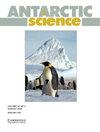The limnology and spectral behaviour of a freshwater lake at Harmony Point, Nelson Island, Antarctica
IF 2
4区 地球科学
Q3 ENVIRONMENTAL SCIENCES
引用次数: 0
Abstract
Abstract The present study investigates the effect of limnology on the spectral reflectance of a freshwater lake, located in an ice-free area in the Antarctic Peninsula. Field-collected samples generated limnological and spectral parameters. This fact indicates that the studied lake has an ultra-oligotrophic/oligotrophic nature based on chlorophyll a (chl a), which registered concentrations below 3 μg l-1 with no total suspended solids, almost neutral pH and transparency equalled by depth. The water spectral behaviour in each sampling station indicates that the benthic characteristics of the lake have a strong influence as the reflectance at the 705 nm wavelength being greater than that at 583 nm signals the presence of soil and/or vegetation at its bottom. Hence, it is believed that the orbital sensors with spectral bands focused on regions between the green and red edge, such as the MultiSpectral Instrument (MSI) sensor, may present better results for distinguishing the different bottom types found in the research area.南极洲尼尔森岛和谐角的一个淡水湖的湖沼学和光谱行为
摘要本研究调查了湖沼学对南极半岛无冰区淡水湖光谱反射率的影响。野外采集的样品产生了湖沼学和光谱参数。这一事实表明,所研究的湖泊具有基于叶绿素a(chl a)的超贫营养/贫营养性质,叶绿素a的浓度低于3μg l-1,没有总悬浮固体,pH值几乎为中性,透明度与深度相等。每个采样站的水光谱行为表明,湖泊的海底特征具有强烈的影响,因为705 nm波长的反射率大于583 nm的反射率,表明其底部存在土壤和/或植被。因此,人们认为,光谱带集中在绿色和红色边缘之间区域的轨道传感器,如多光谱仪器(MSI)传感器,可能会为区分研究领域中发现的不同底部类型提供更好的结果。
本文章由计算机程序翻译,如有差异,请以英文原文为准。
求助全文
约1分钟内获得全文
求助全文
来源期刊

Antarctic Science
地学-地球科学综合
CiteScore
3.60
自引率
6.20%
发文量
42
审稿时长
3 months
期刊介绍:
Antarctic Science provides a truly international forum for the broad spread of studies that increasingly characterise scientific research in the Antarctic. Whilst emphasising interdisciplinary work, the journal publishes papers from environmental management to biodiversity, from volcanoes to icebergs, and from oceanography to the upper atmosphere. No other journal covers such a wide range of Antarctic scientific studies. The journal attracts papers from all countries currently undertaking Antarctic research. It publishes both review and data papers with no limits on length, two-page short notes on technical developments and recent discoveries, and book reviews. These, together with an editorial discussing broader aspects of science, provide a rich and varied mixture of items to interest researchers in all areas of science. There are no page charges, or charges for colour, to authors publishing in the Journal. One issue each year is normally devoted to a specific theme or papers from a major meeting.
 求助内容:
求助内容: 应助结果提醒方式:
应助结果提醒方式:


